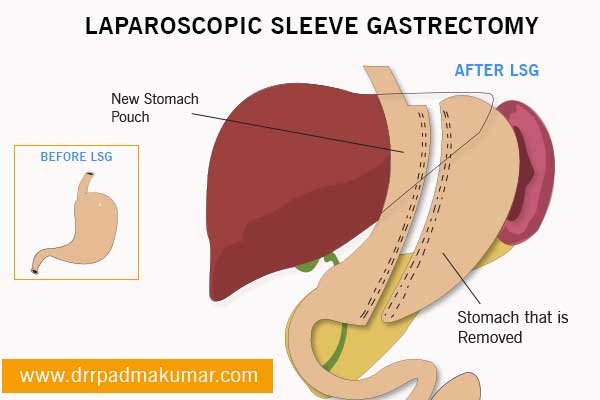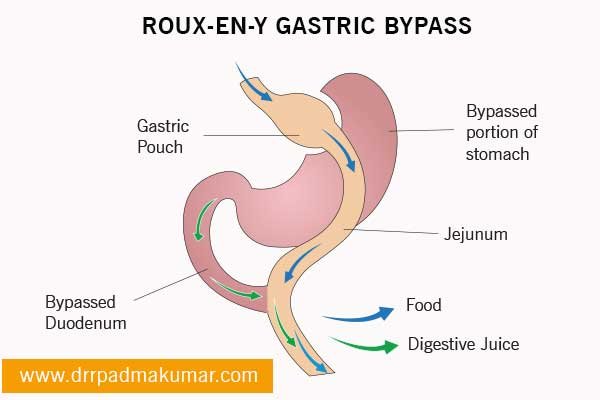Laparoscopic Surgeries
Laparoscopy
Laparoscopy: As the name suggests ‘Laparo’ means abdomen, ‘Scopy’ means vision. The surgeon visualizes the inner parts of the patients body through the laparoscope which is a small cut (incision 5-10 mm) on the abdomen. The magnified (up to 20 times larger) vision of the interior parts through the telescope is quite different from the traditional open surgery. Due to the small incision inflicted on the patients, it is also known as Minimally Invasive Surgery (MIS), Band – aid surgery and rarely pin hole surgery. Laparoscopic Surgeries are also known as Minimally Invasive Surgeries (MIS) as it uses keyhole incisions.
Laparoscopic Surgeries
Dr. R. Padmakumar performs various laparoscopic surgeries in Kerala.

Laparoscopic Sleeve Gastrectomy
Laparoscopic Sleeve Gastrectomy is a surgical procedure performed for weight loss in Obese patients. The outer margin of the stomach is removed laparoscopically to restrict the amount of intake of food. This leaves the size of the stomach to about 15% of the original size of the stomach.
Read More
Gastric Bypass – Roux-en-Y
Gastric Bypass is also done laparoscopically. This is also a surgical weight loss procedure. The stomach is divided into a small upper pouch and a large lower pouch. The small intestine is then reattached to the pouch that creates a bypass for food.
Read More
Mini Gastric Bypass
Mini Gastric Bypass is also another weight loss procedure done laparoscopically using a laparoscope
Laparoscopic Gastroplasty
Laparoscopic Gastroplasty is another Weight Loss procedure. The advantages of Laparoscopic Gastroplasty compared to other Weight Loss procedures are that it is superior to intragastric Balloon as the results are sustained even after many years. No chance of bleeding as there is no cutting involved. No leak as the stomach is not resected. Less expensive. Less duration of anesthesia. Early return to normal life. Reversible if patient insists.
Endoscopic Thyroid Surgery
Endoscopic Thyroid Surgery is a scarless thyroid surgery procedure in which the thyroid surgery is carried out endoscopically via small incisions made near the axilla. The whole thyroid or part of the thyroid can be removed endoscopically.
Laparoscopic Appendectomy
Laparoscopic Appendectomy is laparoscopic removal of the appendix performed to remove an inflamed appendix.
Laparoscopic Splenectomy
Removal of spleen
Laparoscopic Bowel Surgery
Laparoscopic Hernia Repairs
Hernia is protrusion of contents of abdomen through defect in abdominal wall. Based on the location of where the hernia develops, it can be classified into various types. Hernia Repairs can be performed through open surgery or laparoscopically. The treatment is to repair these defects by supporting with a mesh. In conventional surgery one has to cut all layers of the abdominal wall to place this mesh; obviously causing major wound, pain and sometimes weakening of tissues.
Laparoscopic Hernia Surgery, that is performing the hernia surgery laparoscopically, has many advantages, which include reduced postoperative pain and discomfort, faster healing, faster return to work, reduced hospital stay, minimal scars, less chance for infection. The procedure is done through 1-cm incision much away from the defect and a much larger mesh can be placed right at the place of starting of hernia. Being more physiological, the outcome is superior with very less chance of recurrence compared to open surgery. No need for 3-6 months rest as in open surgery. Even multiple hernias can be tackled through the single 1 cm incision plus two 3 mm punctures rather than cutting long at each place.
Different types of hernias can be repaired laparoscopically. These include – Inguinal Hernia, Hiatal Hernia, Ventral Hernia, Obturator Hernia, Femoral Hernia, Umbilical Hernia, Incisional Hernia.
Laparoscopic Cholecystectomy
Cholecystectomy is a procedure performed to remove the gallbladder from the body. It becomes necessary to remove the gallbladder when there are gallstones present in the gallbladder. Gallstones are crystals that form inside the gallbladder and its presence in the bladder or duct results in swelling, pain, indigestion and vomiting as they block the flow of enzymes through bile duct to the small intestine. If left untreated, it can cause severe medical condition and leads to jaundice. Laparoscopic Cholecystectomy is a minimally invasive procedure and helps in faster recovery and less pain.
Doctors, patients and their bystanders can now relax. The conventional methods of open surgery by cutting and stitching body parts are soon going to be extinct. Thanks to the advancement of Science and Technology in the medical field.

Different laparoscopic Sugeries in Kerala performed by Dr. R. Padmakumar and Team, Laparoscopic Sleeve Gastrectomy, Laparoscopic Hernia Repair, Endoscopic Thyroidectomy, Laparoscopic Appendectomy, Laparoscopic Cholecystectomy, Laparoscopic Splenectomy, Laparoscopic Bowel Surgery, Laparoscopic Gastrojejunostomy, Colostomy, Various Cancer Sugeries, Low Anterior Resection, Laparoscopic Hysterectomy, Laparoscopic surgery for uterine tumours and prolapse, Laparoscopic surgery for ovarian tumors/ cancers and cysts, Laparoscopic Sugery for prolapsed rectum

Advantages of Laparoscopic Surgeries include Reduced Postoperative Pain, Faster healing and recovery, Faster return to work, Reduced Hospital Stay, Minimal scars, Less chance for infection, Better Surgical Results, Negligible Blood Loss
Laparoscopic Gastrojejunostomy
Gastrojejunostomy is a surgical procedure performed when the individual is suffering from stomach cancer causing obstruction in the passage of food into the gut. During the surgery a part of the small intestine known as the jejunum is opened and stitched or clipped on to the stomach wall to bypass the obstructed area of the stomach. Laparoscopic Gastrojejunostomy is performing gastrojejunostomy through keyhole incisions.
Laparoscopic Adrenalectomy
Laparoscopic Adrenalectomy is a minimally invasive surgical method to remove affected adrenal gland along with the tumor. Adrenal diseases can be caused by variation in the production of hormones; ie, when too much hormone is produced or when too little hormone is produced.
Origin and History of Laparoscopic Surgeries
The first laparoscopic surgeries were performed in dogs in 1902 by George Kelling of Dresden Germany. The first laparoscopic surgery in humans was conducted by Hans Christian Jacobaeus of Sweden in 1910. The first laparoscopic cholecystectomy (removal of gallbladder) in humans was done in 1987 in France. The introduction of high definition camera, medical monitor and good electro surgical units made the procedure easier. In India the procedure is in practice for the past 20 years and is getting popular due to its very high advantages over conventional surgery.
How is Laparoscopy performed?
The laparoscope, a telescopic rod lens system, is put through the small incision made around the umbilicus of the patient. The system is connected to a video camera (single chip or three chip). A fiber optic cable system connected to a ‘cold light source (halogen or xenon)’ is used to illuminate the operative field. The patient’s abdomen is distended with carbon dioxide gas to create a working and viewing space for the surgeon. Carbon dioxide is used as it is familiar to the human body and gets removed by the respiratory system if it gets absorbed through tissue. The surgical equipments are introduced into the abdomen through two 3mm incisions (punctures) made near the earlier entry. The skilled surgeon, by looking at the monitor can perform surgery with precision and perfection.
Advantages of Laparoscopic Surgery
Since only two or three tiny incisions are made in the abdomen the patient feels less pain. It reduces blood loss, compared to traditional open surgery. There is less need for blood transfusion, hence less chance for acquiring infection like Hepatitis B, HIV, Malaria etc. There is significant reduction in scar and wound infection. Scant use of antibiotics and painkillers is possible unlike in open surgery. Hospital stay for patients is limited to one or two days. Shorter hospital stay means less burden for the patient and relatives. Unlike open surgery, fast recovery through laparoscopic method saves money and consumption of medicines. The patients can return to normal work and profession within a shorter period. As external snitching is completely avoided, Laparoscopic method provides excellent cosmetic outcome. The diseased organ is tackled inside the abdomen and intestines are not brought out to be in contact with outside environment as in open surgery. Hence chance of adhesion (sticking together of intestines) is minimized in laparoscopy to the least.
Laparoscopy enables doctors for better diagnosis. Since the organs are seen in magnified form, the surgeon performs with high precision. There is less chance of contact with blood and tissue fluids. Hence less chance for surgeon and staff to contract dreaded infections.
The surgeon can visualize the entire abdominal cavity of the patients, by just turning the telescope in all directions. Laparoscopic method helps in detecting alternate pathology than one which is entertained pre operatively; which is not possible in open surgery due to limited access and vision. As one can start feeding the patient early in laparoscopy, the gastrointestinal problems are also minimized and nutrition is well maintained. Finally patients is highly benefitted. Use of advanced energy sources like harmonic scalpel reduces tissue damage and hence the resultant recovery time and tiredness.
Laparoscopy – Prospective fields
Laparoscopic treatment and surgery are ideal in the case of removal of gallbladder (laparoscopic cholecystectomy) , appendix, ovary, uterus etc. It is very good for, hernia repair, bowel surgery and surgery on kidney and for surgery for weight reduction. The term Arthroscopy refers to the keyhole procedure for treatment of bone and joint problems and thoracoscopy for the procedure in chest.
How can the diseased organs be taken out through small opening ?
Usually the organs or affected parts removed are not too big. An appendix, gall bladder, cyst wall etc. are of small size which can come out through the one 10mm Incision made earlier. For females, specimen like uterus comes out through the vagina without any need for abdominal incisions. If necessary, using instruments like morcellator the specimen can be sucked out in smaller pieces completely.
Is cancer treatment possible?
Laparoscopic treatment has many advantages in detecting and removing tumors. Eight major scientific studies have proved that laparoscopic surgery is better than open surgery for surgically treating cancer. Postoperative complications in lungs, veins, intestines etc are significantly reduced by the fact that patients are not confined to bed after laparoscopy. As wounds are less, patients need not wait for the wounds to heal and early initiation of chemotherapy is possible. Waiting for wound healing makes the microscopic reminant Cancer to grow before chemo tackles it. Cancers of uterus, intestine, kidney etc. are tackled laparoscopically all over the world. Laparoscopy avoid major negative laparotomies which increase the tiredness, sickness of patients when the tumour is not surgically removable.
Obesity & Diabetic Surgery
Laparoscopic method may be the only safe option in bariatric surgery. Bariatric surgery is considered when the body mass index (BMI) is more than 35. It is really difficult to perform open surgery in obese patients and they go in for respiratory and wound complications. Highly desirable results are obtained by a laparoscopic approach which gives a very good access to the stomach.
Laparoscopic bariatric surgery brings back obese patients to normalcy by getting rid of the extra fat which was causing various medical illness like diabetes, high blood pressure, high cholesterol, cardiac illness , breathing difficulty , joint pain, cancers , infertility etc. Keyhole surgery gives excellent result in attaining long term resolution of Diabetes Type II.
Laparoscopic Surgeries in Gynecology & infertility
All gynaec procedures can be performed very successfully by laparoscopy and gives much better results in infertility. Taking out baby (Cesarean) may be the only procedure which may necessitate a wound. Opening abdomen for the removing uterus or cyst of any size is unnecessary as the laparoscopic surgery accomplish better outcome.
Thyroid surgery (Endoscopic Thyroidectomy)
The surgical solution available in most of the places is open thyroidectomy which involves a large transverse cut across the lower part of the neck. This definitely leads to an unsighty scar which is not acceptable, especially for women. The endoscopic thyroidectomy – the keyhole or minimally invasive technique is a very good alternative to other methods. It gives excellent cosmetic outcome especially when done by an axillary approach. It gives equal or even a better surgical outcome as far as the actual thyroid nodule management is considered.
The earlier belief was that the endoscopic no neck scar option for thyroid swellings are applicable to lesions of less than 4 cm size. But we have observed that swellings of size of even 12 – 15 cm can be tackled very successfully through this method. The only pre-requisite will be a surgeon with good experience, in both laparoscopic surgeries and thyroid surgeries. Any kind of pathologies like benign or cancerous nodules, thyoiditis can be safely tackled by endoscopic thyroidectomy.
Thoracoscopy
Keyhole surgery is an excellent method for treating disease in the chest. Lung cancers, & recurrent pneumathorax (air leak) , chest wall tumors and infection can be tackled through 1 cm cut using telescopic system. In conventional surgery (Thoracotomy) the 30-40 cm incision with rib cutting-mainly for access and vision cause extreme discomfort to patient at every breath for at least six months. The procedures can be performed with high precision and perfection with out these troubles when performed by the thoracoscopic method.
Previous Surgery & Associated medical Illness
Previous open surgery or laparoscopy in not a contra indication for laparoscopy. Medical illness like diabetes, Hypertension, asthma, cardiac illness though increase risk for anaesthesia the laparoscopic surgery can be performed comfortably without increasing the risk . Less need for confinement to bed in laparoscopy actually reduces the post op complications in these patients with comorbid illness. Laparoscopic surgeries can be performed under regional anaesthesia (spinal / epidural) when general anaesthesia cannot be given.
What are the risks in Laparoscopy?
Laparoscopic procedures do not carry any additional risks, as nothing which can harm the body is used . Surgery related risks are very minimum compared to open surgery. The safety of the patient and the precision in treatment have increased manifold with the availability of ultrasonic and radio frequency instruments. Keeping blood in reserve is mostly not needed unlike in open surgery. Pain and infection after surgery is extremely rare for the patients in laparoscopy. The diseased organ is removed completely and no chance of recurrence of the problem, only because procedure was done laparoscopically.
There is no need for physical rest for the patient and can resume normal diet in twelve hours. No special preparation is required prior to laparoscopy. Four to six hours of fasting which mandates anaesthesia requirements is sufficient.
Training
A good hand, eye coordination is required for laparoscopy. Lack of trained surgeons in laparoscopy is a major problem in India like other parts of the world. After sustained training to surgeons with easy availability of sophisticated instruments; major hospitals are now getting fully equipped to handle laparoscopic surgery. Surgeons should not give a prolonged illness & discomfort by a wound when patient comes for an illness which can be cured by surgery in 24hrs. Every surgeon should learn Laparoscopy and practice it. Lap surgery has taken away the fear of surgery-the pain. It is very pleasing to see patients walking around even on the 1st day after undergoing major surgery laparoscopically . But open surgery patient is confined to bed and require many persons to help, even to move.
Financial advantage
Through laparoscopic surgery costs higher than open surgery, it has its own advantages financially. For laparoscopic surgery, a patient need not stay in the hospital for more than two days. It will be week long stay in the hospital for open surgery. Prolonged stay in hospital incurs expenses for accommodation, food, medicine etc. The patient after laparoscopic surgery can join work much sooner than those undergoing open surgery. This will have an impact on the income of family. The expenses incurred for bystanders and their availability are minimized in the case of laparoscopy. These indirect expenses definitely over weighs the apparent direct cost for laparoscopy.
The wound related problem like infection, adhesion and hernia leads to further expenses in open surgery group even later.
Publications
- Vitamin D deficiency – Surgeon’s Perspective: Dr R Padmakumar et al.
- Laparoscopic Hernia Repair - How to Learn at Ease
- Successful bowel surgery in patient with hemoglobin 2 g/dL without blood transfusion
- “PK Band” in Laparoscopic Hernia Repair
- Endoscopic Ectopic Thyroidectomy
- Management of polycythemia vera by endoscopic parathyroidectomy
- Total endoscopic excision of branchial cyst in a child aged 3 years
- Handbook on Bariatric Procedures
- A retrospective analysis of 200 axillary route thyroidectomy cases
- Efficacy of Laparoscopic Sleeve Gastrectomy on type 2 diabetes with BMI less than 35: a retrospective study
- Sleeve Gastrectomy with concommitant Abdominoplasty: A Novel procedure
- Hyperhidrosis – Laparoscopic Lumbar Sympathectomy – a case report
- Laparoscopy set to replace Traditional Treatment – Laparoscopy vs Open
- Effectiveness of Minimally Invasive Hybrid Surgery for Ileal Interposition (MIHSII) for the Resolution of Type 2 Diabetes.
- Efficacy of laparoscopic sleeve gastrectomy on type 2 diabetes with BMI less than 35: a retrospective study.
Contact Details
Dr. R. Padmakumar
MBBS, DNB, MNAMS, DipALS, FAIS, FIMSA, FCLS, FRCS (GL)
Senior Consultant Laparoscopic and Metabolic Surgeon &
Director - Verwandeln
Institute (Transforming Lives)
CMD - Keyhole Clinic,
Metro
Pillar no. 448, Edappally, Kochi, Kerala, India
HOD - VPS Lakeshore Hospital, Maradu, Kochi, Kerala, India
(Specialist in Laparoscopy, Hernia, Cancer, Obesity Surgery or Bariatric Surgery, Diabetes
Surgery, Endoscopic Thyroid Surgery,
Thoracoscopy, Intragastric Balloon)
Website Dr. R. Padmakumar - www.drrpadmakumar.com
Mobile: +919447230370, +919846320370
Email: drrpadmakumar@gmail.com
Past Chairman, Association of Surgeons of India - Kerala Chapter, 2019 - 2020
National President - Indian Hernia Society (2016)
GC Member, Association of Surgeons of India (2013 -
2018)
Vice President- Society of Endoscopic
and Laparoscopic Surgeons of India
Jt. Secretary - Indian Association of Endocrine
Surgeons (2016)
Founder Member, Obesity and Metabolic Surgery Society Of India
Founder Member, Association of Minimal Access
Surgeons of India
International Faculty of IASGO on Hernia and
Diabetic Surgery
International Faculty of IFSO on Diabetic Surgery
Associate Editor : Diabetes and Obesity International Journal


Metro Pillar No. 448, Edappally, Kochi
Tel: 9847296357 / +919645222401
www.keyholeclinic.in
